预约演示
更新于:2025-10-29
Lornoxicam
氯诺昔康
更新于:2025-10-29
概要
基本信息
非在研机构 |
权益机构- |
最高研发阶段批准上市 |
最高研发阶段(中国)批准上市 |
特殊审评- |
登录后查看时间轴
结构/序列
分子式C13H10ClN3O4S2 |
InChIKeyWLHQHAUOOXYABV-UHFFFAOYSA-N |
CAS号70374-39-9 |
关联
32
项与 氯诺昔康 相关的临床试验CTRI/2024/02/062947
Comparative evaluation of efficacy of single pre-emptive dose of Extended release Lornoxicam versus Prolonged release Diclofenac for surgical removal of impacted 3rd molar in Indian population: A prospective, randomized, triple blind, split mouth clinical trial. - NIL
开始日期2024-03-02 |
申办/合作机构- |
ChiCTR2200064785
Effect of acupuncture and tamsulosin on ureteral stone clearance: a single-center real-world study
开始日期2022-10-17 |
申办/合作机构- |
NCT05679453
Comparison of Lornoxicam and Etodolac on Edema, Trismus and Pain After Third Molar Surgery
Our study aimed to compare the effect of lornoxicam and etodolac on postoperative pain, edema and trismus following lower third molar extraction
开始日期2022-07-20 |
申办/合作机构- |
100 项与 氯诺昔康 相关的临床结果
登录后查看更多信息
100 项与 氯诺昔康 相关的转化医学
登录后查看更多信息
100 项与 氯诺昔康 相关的专利(医药)
登录后查看更多信息
776
项与 氯诺昔康 相关的文献(医药)2025-10-01·JOURNAL OF PHARMACOLOGY AND EXPERIMENTAL THERAPEUTICS
Antithrombotic potential of lornoxicam and possible mechanistic pathways
Article
作者: Khan, Arif-Ullah ; Khalid, Waseem ; Ali, Fawad
Lornoxicam is traditionally used as an anti-inflammatory and analgesic drug. Recent studies suggest that nonsteroidal anti-inflammatory drugs can influence platelet and coagulation pathways. However, the antithrombotic and cardiopulmonary protective potential of lornoxicam remains unexplored. This study addressed this gap by evaluating lornoxicam's effects on thrombosis, myocardial infarction (MI), and pulmonary embolism (PE) using in silico, in vitro, and in vivo models. Docking analysis with 16 target proteins revealed novel interactions with lornoxicam, suggesting potential antithrombotic and cardiopulmonary benefits of beyond its cyclooxygenase (COX)-mediated actions. AutoDock (version 4.2.6) was used with default parameters and empirical force field (Exhaustiveness: 8). High binding affinities (E-value > -9.0 kcal/mol) were observed for COX-1, glycoprotein IIb/IIIa, antithrombin III, COX-2, and nuclear factor kappa light chain enhancer of activated B cells (NFκB), and molecular dynamics simulations confirmed stable ligand-protein complexes. In arachidonic acid-induced platelet aggregation, lornoxicam showed concentration-dependent inhibition (77.8% at 10 μM, IC50 = 0.61 μM) compared with 94.81% inhibition by aspirin (10 μM). In ADP-induced aggregation assays, inhibition was less pronounced (23.21% at 10 μM, IC50 = 20.6 μM). Lornoxicam significantly prolonged prothrombin time, activated partial thromboplastin time, thrombin time, and clot lysis at 1, 3, and 10 μM concentrations (P < .001 vs saline). The cardioprotective potential of lornoxicam was confirmed via an isoprenaline (ISO)-induced MI model in rats, while its protective effect on PE was assessed using a self-embolus-induced PE rat model. Lornoxicam protected the heart and lung tissues of rats against histological damage and infarction by decreasing oxidative stress and inflammatory responses. This effect was due to reduced expression of NFκB, tumor necrosis factor alpha, COX-2, NOD-like receptor family, pyrin domain containing 3, and platelet-derived growth factor beta (in the lungs), as confirmed via immunohistochemical analysis, ELISA, and reverse-transcription polymerase chain reaction. This study opens a new avenue for the repurposing and prophylactic use of lornoxicam in patients more prone to thrombotic disorders. SIGNIFICANCE STATEMENT: The in silico, in vitro, and in vivo experiments in this study revealed the excellent antithrombotic potential and protective effect of lornoxicam on myocardial infarction and pulmonary embolism, even at lower doses. This study proposes that lornoxicam treatment, just like aspirin, at lower doses could be an appropriate prophylactic option in patients who are more prone to myocardial infarction and pulmonary embolism.
2025-09-01·INTERNATIONAL JOURNAL OF BIOLOGICAL MACROMOLECULES
Regenerated cellulose fibers for preparation of alginate and lornoxicam-loaded medical knitted textiles: A response surface optimization study
Article
作者: Elsayed, Ebtesam W ; Emam, Maha F ; Emara, Laila H ; El Naga, Heba Tolla El Sayed Abo ; Abd El-Aziz, Manar Y
Regenerated cellulose and alginate have been increasingly utilized to prepare medical textiles due to their biocompatibility. A 33-face-centered design was proposed to prepare and optimize alginate and lornoxicam (LRX)-loaded textiles using bamboo and modal regenerated cellulose fibers. The effects of different factors (bamboo%, X1, LRX amount, X2, and sonication time, X3) on the textiles' performance were studied. The textiles were evaluated for physical, mechanical, and surface properties, LRX loading%, particle size, zeta-potential, dissolution, and release kinetics. Bamboo% exhibited a significant negative effect on the textile weight (p-value = 0.0376). LRX amount showed significant positive effects on flexural rigidity, tensile strength, and particle size (p-value = 0.0379, 0.0086, and 0.0004, respectively). The sonication time showed a significant negative effect on LRX particle size and a positive effect on the magnitude of zeta-potential (p-value = 0.0204, and 0.0208, respectively). All the samples showed high stability as indicated by the absolute values of Zeta-potential (>51.8 mV) which might be attributed to the effect of alginate as a stabilizer. The studied formulations followed different LRX release models suggesting erosion, Fickian, non-Fickian diffusion, and super case II mechanisms. A multiple-response optimization was employed, and the proposed design of experiments enabled the prediction of the optimal factors' levels required for the target responses.
2025-08-07·CURRENT DRUG METABOLISM
Influence of Orange Oil on Skin Permeability, Dermatokinetics, and In Vivo Anti-inflammatory Properties of Lornoxicam-loaded Niosomal Gel
Article
作者: Sahoo, Biswa Mohan ; Rajangam, Jayaraman ; Dhar, Arghya K. ; P., Dharani Prasad ; Palei, Narahari N.
Introduction::
Lornoxicam is a non-steroidal anti-inflammatory drug belonging to the oxicam class. This study aimed to develop a niosomal gel containing orange oil for improving the anti-inflam-matory effect of lornoxicam.
Methods::
Lornoxicam-loaded niosomes (LOR-OR-NIO) were prepared using film hydration followed by the sonication method. Particle size, entrapment efficiency, and ex vivo permeation were all consid-ered during the optimization of the niosomal gels by employing the Box-Behnken design. Dermatoki-netics and in vivo anti-inflammatory studies were performed using male Wistar rats.
Results::
The particle size, entrapment efficiency, and skin permeation ability of the optimized LOR-OR-NIO formulation were found to be 354.3 nm, 83.56 %, and 105.63 µg/cm2, respectively. The ex vivo studies indicated that the optimized LOR-OR-NIO gel demonstrated superior drug penetration properties (105.43 µg/cm2) compared to both the LOR-NIO gel (69.23 µg/cm2) and the LOR gel (35.34 µg/cm2). The activation energy values of LOR gel, LOR-NIO gel, and LOR-OR-NIO gel were 2.74 Kcal mol-1, 1.93 Kcal mol-1, and 0.94 Kcal mol-1, respectively.
Discussion::
The lower activation energy of the LOR-OR-NIO gel contributed to more skin penetration of the drug. Dermatokinetics investigation demonstrated that the LOR-OR-NIO gel had superior pene-tration in the epidermal and dermal areas compared to the LOR gel. In vivo anti-inflammatory studies indicated that the LOR-OR-NIO gel exhibited greater edema inhibition compared to both the LOR-NIO gel and LOR gel. These results demonstrated the enhanced anti-inflammatory activity of the LOR-OR-NIO gel.
Conclusion::
The study concluded that orange oil enhanced skin permeability and influenced the derma-tokinetics of the LOR-OR-NIO gel, leading to an improvement in in vivo anti-inflammatory properties.
58
项与 氯诺昔康 相关的新闻(医药)2025-10-28
·谈医说药
睿昂基因:第三季度营收为3435.53万元,同比下降37.35%;净利润亏损917.5万元。前三季度营收为1.39亿元,同比下降26.64%;净利润亏损562.07万元。奥赛康:第三季度营收为4.26亿元,同比下降7.67%;净利润为6332.72万元,同比增长23.15%。前三季度营收为14.34亿元,同比增长3.57%;净利润为2.23亿元,同比增长75.81%。博瑞医药:全资子公司博瑞制药(苏州)有限公司参加了国家组织药品联合采购办公室组织的第十一批全国药品集中采购的投标工作,博瑞制药产品地诺孕素片拟中标本次集中采购。地诺孕素片于2024年12月获得国家药品监督管理局核准签发的药品注册证书,为公司新上市产品,2025年1-9月产生销售收入173.51万元。百奥泰:第三季度营收为2.42亿元,同比增长34.92%;净利润亏损9892.58万元。前三季度营收为6.84亿元,同比增长17.57%;净利润亏损2.24亿元。博济医药:第三季度营收为2.23亿元,同比增长3.78%;净利润为634.4万元,下降51.73%。前三季度营收为5.84亿元,同比增长5.06%;净利润为2191.39万元,下降49.36%。白云山:第三季度营收为197.71亿元,同比增长9.74%;净利润为7.94亿元,同比增长30.28%。前三季度营收为616.06亿元,同比增长4.31%;净利润为33.1亿元,同比增长4.78%。报告期内公司及下属企业顺应市场需求提升加大拓展力度,实现销售收入同比上升,进而有效带动利润增长。辰欣药业:第三季度营收为8.44亿元,同比下降9.41%;净利润为1.53亿元,同比增长19.61%。前三季度营收为25.84亿元,同比下降13.94%;净利润为3.82亿元,同比下降4.05%。大博医疗:第三季度营收为6.66亿元,同比增长17.82%;净利润为1.8亿元,同比增长77.49%。前三季度营收为18.76亿元,同比增长22.69%;净利润为4.25亿元,同比增长77.03%。东宝生物:第三季度营收为1.64亿元,同比下降13.29%;净利润为1148.22万元,同比下降23.10%。前三季度营收为5.33亿元,同比下降15.84%;净利润为4844.95万元,同比下降26.89%。东星医疗:第三季度营收为1亿元,同比下降1.97%;净利润亏损8349.45万元。前三季度营收为2.84亿元,同比下降10.21%;净利润亏损5320.16万元,主要系三季度计提孜航精密商誉减值损失约1亿元。佛慈制药:第三季度营收为1.95亿元,同比下降7.14%;净利润为797.78万元,同比增长167.92%。前三季度营收为6.24亿元,同比下降11.92%;净利润为3808.24万元,同比下降2.54%。复星医药:2025年10月28日,公司董事会决议批准建议筹划公司附属公司复星安特金(成都)生物制药有限公司于香港联合交易所有限公司的分拆上市。复星安特金成立于2012年7月,专注于人用疫苗的研发、生产及销售,已搭建细菌性疫苗和病毒性疫苗的技术平台。复星医药:控股子公司复星医药产业拟作为LP与其他11方投资人共同出资设立目标基金。目标基金计划募集资金人民币10亿元,其中:复星医药产业拟现金出资人民币1亿元认缴目标基金中的等值财产份额。目标基金设立后,将成为本公司之联营企业。复星医药:第三季度营收为98.79亿元,同比下降5.46%;净利润为8.21亿元,同比增长4.52%。前三季度营收为293.93亿元,同比下降4.91%;净利润为25.23亿元,同比增长25.50%。冠昊生物:第三季度营收为9261.08万元,同比增长4.72%;净利润为631.44万元,下降17.87%。前三季度营收为2.93亿元,同比增长5.52%;净利润为2671.85万元,下降4.02%。华熙生物:第三季度营收为9.03亿元,同比下降15.16%;净利润为3152.85万元,同比增长55.63%。前三季度营收为31.63亿元,同比下降18.36%;净利润为2.52亿元,同比下降30.29%。华森制药:第三季度营收为1.84亿元,下降6.30%;净利润为1850.51万元,下降32.37%。前三季度营收为6.26亿元,增长1.90%;净利润为7245.56万元,下降2.84%。汇宇制药:全资子公司四川汇宇海玥医药科技有限公司参与了国家组织药品联合采购办公室组织的第十一批全国药品集中采购投标工作。根据联采办发布的《全国药品集中采购拟中选结果公示》,公司1个产品拟中标本次集中采购。拟中选产品为美索巴莫注射剂,主要用于急性骨骼肌疼痛或不适症状的治疗,包装规格为10ml:1g,拟中选价格为11.59元,采购周期至2028年12月31日。华纳药厂:公司参加了国家组织药品联合采购办公室组织的第十一批全国药品集中采购投标工作,盐酸贝尼地平片拟中标。该药品用于原发性高血压、心绞痛的治疗,规格为8mg,包装规格为28片/盒,拟中标价格为7.19元/盒。采购周期自中选结果执行之日起至2028年12月31日。公司2024年销售收入16.63万元,2025年上半年销售收入509.76万元。若后续签订采购合同并执行,将有利于进一步扩大销售规模,提升市场占有率和品牌影响力,对公司未来经营业绩产生积极影响。昊帆生物:第三季度营收为1.64亿元,同比增长59.45%;净利润为2335.35万元,下降23.50%。前三季度营收为4.35亿元,同比增长32.47%;净利润为9923.83万元,同比增长3.01%。红日药业:第三季度营收为13.54亿元,同比下降6.32%;净利润为213.29万元,同比下降89.40%。前三季度营收为41.49亿元,同比下降6.59%;净利润为8076.29万元,同比下降52.03%。华邦健康:第三季度营收为31.41亿元,同比增长5.13%;净利润为2.23亿元,同比增长61.33%。前三季度营收为90.86亿元,同比增长1.98%;净利润为6.12亿元,同比增长35.37%。海思科:公司近日收到国家药品监督管理局下发的《受理通知书》,HSK44459片(片剂)的境内生产药品注册临床试验申请获受理,适应症为炎症性肠病。HSK44459片是公司自主研发的治疗炎症性肠病的药物,临床前研究结果表明其具有独立知识产权,疗效确切,安全性好。目前,HSK44459片已获得“间质性肺疾病”、“白塞病”、“银屑病”和“特应性皮炎”适应症的临床试验批准通知书,均在进行Ⅱ期临床研究。海思科:第三季度营收为12.99亿元,同比增长22.05%;净利润为1.66亿元,下降23.32%。前三季度营收为33亿元,同比增长19.95%;净利润为2.95亿元,下降22.66%。峆一药业:第三季度营收为4813.94万元,同比下降18.88%;净利润为552.09万元,同比下降33.29%。前三季度营收为2.11亿元,同比增长7.12%;净利润为4594.64万元,同比增长22.85%。九强生物:第三季度营收为3.43亿元,同比下降17.39%;净利润为9722.7万元,同比下降20.96%。前三季度营收为10.12亿元,同比下降18.24%;净利润为2.72亿元,同比下降27.03%。嘉应制药:第三季度营收为9449.86万元,同比增长19.01%;净利润为171.17万元,同比增长161.26%。前三季度营收为2.93亿元,同比增长13.03%;净利润为2179.43万元,同比增长658.50%。津药药业:第三季度营收为6.43亿元,同比下降16.61%;净利润为2023.56万元,同比下降54.70%。前三季度营收为22.32亿元,同比下降13.24%;净利润为6953.99万元,同比下降62.75%。开立医疗:第三季度营收为4.95亿元,同比增长28.42%;净利润亏损1351.92万元。前三季度营收为14.59亿元,同比增长4.37%;净利润为3351.11万元,同比下降69.25%。凯普生物:第三季度营收为1.71亿元,同比下降15.14%;净利润亏损3809.19万元,同比增长79.41%。前三季度营收为4.86亿元,同比下降20.38%;净利润亏损1.28亿元,同比增长51.25%。康恩贝:第三季度营收为16.17亿元,同比增长10.42%;净利润为2.3亿元,同比增长69.11%。前三季度营收为49.76亿元,同比增长1.27%;净利润为5.84亿元,同比增长12.65%。康恩贝:全资子公司杭州康恩贝制药有限公司参加了国家组织第十一批药品集中带量采购工作。经评审,杭州康恩贝的腺苷钴胺胶囊拟中标。腺苷钴胺胶囊拟中标价格为3.81元/盒,拟主供省(区)中标数量为832.24万粒,供应省份包括四川、湖北、宁夏。采购周期为3年,厂牌约定采购量为262万粒。此次中标有利于产品快速放量销售及市场的开拓,对公司未来的经营业绩产生积极影响。康众医疗:根据2025年10月28日询价申购情况,本次询价转让初步确定的转让价格为22.99元/股。参与本次询价转让报价的机构投资者家数为12家,涵盖了基金管理公司、合格境外机构投资者、证券公司、私募基金管理人等专业机构投资者。参与本次询价转让报价的机构投资者合计有效认购股份数量为600.2万股,对应的有效认购倍数为1.28倍。本次询价转让拟转让股份已获全额认购,初步确定受让方为11家机构投资者,拟受让股份总数为470万股。科伦药业:公司及子公司参加了国家组织药品联合采购办公室组织的第十一批全国药品集中采购的投标工作,公司产品马来酸阿伐曲泊帕片、艾曲泊帕乙醇胺片、复方醋酸钠林格注射液、阿戈美拉汀片拟中标。其中,艾曲泊帕乙醇胺片2024年度销售收入为1994.23万元,复方醋酸钠林格注射液2023年度销售收入为1772.63万元,2024年度销售收入为793.31万元。康弘药业:第三季度营收为11.7亿元,同比增长4.75%;净利润为3.03亿元,同比增长7.71%。前三季度营收为36.24亿元,同比增长6.23%;净利润为10.33亿元,同比增长6.08%。美康生物:第三季度营收为3.99亿元,下降12.71%;净利润为370.01万元,下降91.94%。前三季度营收为11.36亿元,下降19.27%;净利润为6053.38万元,下降73.02%。迈普医学:股东唐莹于2025年7月30日至2025年10月27日通过集中竞价交易方式减持公司股份66.51万股,减持均价77.49元/股,占公司总股本0.9920%,占公司剔除回购总股本0.9955%,减持计划已实施完成。减持前,唐莹持股150.6万股,占2.2640%;减持后持股84.09万股,占1.2541%。唐莹与一致行动人叶涛合计持有231.09万股,占3.4465%。派林生物:第三季度营收为6.32亿元,下降16.23%;净利润为1.21亿元,下降43.74%。前三季度营收为16.18亿元,下降14.40%;净利润为3.57亿元,下降34.19%。荃信生物:公司与罗氏达成全球独家合作与许可协议,根据协议,公司授予罗氏开发、生产及商业化QX031N的全球独家权益。公司预计将获得一次性、不可退还且不可抵扣的首付款7500万美元,并有资格获得与产品开发、监管批准及商业化相关的至多9.95亿美元里程碑付款,以及潜在未来产品销售的梯度特许权使用费。
荃信生物:10月27日公司自主研发的鲁塞奇塔单抗(QX002N)治疗强直性嵴柱炎(ankylosing spondylitis, AS)的中国III期临床研究成果以口头报告形式亮相在美国芝加哥举办的2025年美国风湿病学会年会(ACR Convergence)。
舒泰神:第三季度营收为5494.11万元,同比下降30.10%;净利润亏损605.4万元,下降1.89%。前三季度营收为1.81亿元,同比下降30.82%;净利润亏损3068.95万元,下降227.71%。寿仙谷:第三季度营收为1.3亿元,同比增长8.51%;净利润为1078.31万元,同比下降30.15%。前三季度营收为4.3亿元,同比下降10.23%;净利润为7634.17万元,同比下降33.47%。上海医药:近日,下属上海上药中西制药有限公司的溴吡斯的明缓释片收到国家药品监督管理局颁发的《药品注册证书》,该药品获得批准生产。溴吡斯的明缓释片可用于治疗重症肌无力,已由BAUSCH公司研发并上市。2024年,中国大陆医院采购溴吡斯的明片金额为6029万元。上药中西已为此药品投入研发费用约1600.9万元。获得批准生产后,有利于扩大市场份额,提升市场竞争力。上海凯宝:第三季度营收为2.14亿元,下降26.61%;净利润为6508.77万元,下降13.13%。前三季度营收为8.19亿元,下降26.95%;净利润为1.87亿元,下降13.83%。漱玉平民:第三季度营收为25.64亿元,同比增长13.48%;净利润为7289.61万元,同比增长294.98%。前三季度营收为74.46亿元,同比增长5.19%;净利润为1.09亿元,同比增长927.37%。泰格医药:第三季度营收为17.75亿元,同比增长3.86%;净利润为6.37亿元,同比增长98.73%。前三季度营收为50.26亿元,同比下降0.82%;净利润为10.2亿元,同比增长25.45%。拓新药业:第三季度营收为8965.38万元,下降16.21%;净利润亏损1188.05万元,下降1,258.62%。前三季度营收为2.72亿元,下降16.64%;净利润亏损3016.11万元,下降1,036.53%。拓新药业:公司于2025年10月28日召开的第五届董事会第八次会议审议通过了《关于对外投资设立子公司的议案》。公司拟在内蒙古自治区呼和浩特市托克托县设立全资子公司“拓新药业(内蒙古)有限公司”,注册资本5000万元。新公司将围绕公司核心业务开展,聚焦发酵相关产品研发、生产与销售。本次对外投资资金全部来源于公司的自有或自筹资金,公司持有其100%股权。泰恩康:第三季度营收为1.79亿元,增长1.02%;净利润亏损567.96万元,下降118.57%。前三季度营收为5.26亿元,下降8.13%;净利润为3140.52万元,下降73.00%。沃森生物:第三季度营收为5.65亿元,同比下降20.25%;净利润为1.2亿元,同比增长40.19%。前三季度营收为17.19亿元,同比下降19.73%;净利润为1.63亿元,同比下降36.24%。兴齐眼药:第三季度营收为7.41亿元,同比增长35.34%;净利润为2.64亿元,同比增长117.45%。前三季度营收为19.04亿元,同比增长32.27%;净利润为5.99亿元,同比增长105.98%。信邦制药:第三季度营收为14.21亿元,下降6.42%;净利润为4512.81万元,下降26.87%。前三季度营收为42.66亿元,下降6.55%;净利润为1.52亿元,下降13.74%。新和成:第三季度营收为55.41亿元,下降6.66%;净利润为17.17亿元,下降3.80%。前三季度营收为166.42亿元,同比增长5.45%;净利润为53.21亿元,同比增长33.37%。新天地:公司于近日与南京知和医药科技有限公司签署一份合作开发及许可协议,双方将在GLP-1类长效多肽创新药物领域开展战略合作。合作内容包括药物研发、生产、商业化和对外交易。本协议的签署不构成关联交易,亦不构成重大资产重组,未触及公司董事会及股东会审议标准。协议不涉及具体金额,对公司本年度的财务状况、经营成果和业绩不会有重大影响。誉衡药业:第三季度营收为5.65亿元,同比下降11.11%;净利润为1.09亿元,同比增长86.86%。前三季度营收为16.65亿元,同比下降10.36%;净利润为2.44亿元,同比增长32.85%。苑东生物:公司于2025年10月27日参加了国家组织药品联合采购办公室组织的第十一批全国药品集中采购的投标工作,公司盐酸去氧肾上腺素注射液、贝前列素钠片2个产品拟中选本次集中采购。盐酸去氧肾上腺素注射液用于治疗麻醉时血管扩张引起的临床低血压,规格包装为5ml:0.5mg*1支,拟中选价格为1.35元/支,采购周期至2028年12月31日。贝前列素钠片用于改善慢性动脉闭塞性疾病引起的溃疡、间歇性跛行、疼痛和冷感等症状,规格包装为20ug*30片*1盒,拟中选价格为13.98元/盒,采购周期至2028年12月31日。亚太药业:第三季度营收为7623.1万元,下降10.21%;净利润亏损798.15万元。前三季度营收为2.28亿元,下降25.59%;净利润为9719.5万元,增长2,909.49%。易明医药:第三季度营收为1.78亿元,同比增长10.37%;净利润为4420.61万元,同比增长1,934.12%。前三季度营收为4.89亿元,同比下降4.65%;净利润为8176.33万元,同比增长95.52%。中关村:公司及相关人员收到中国证券监督管理委员会北京监管局警示函。警示函指出,公司养老业务存在部分收入和成本确认跨期、部分业务原始单据留存不完善、销售提成账务处理不恰当、租金减免财务核算不准确等问题。公司治理方面存在股东会、董事会会议记录瑕疵,个别制度修订不及时、执行不规范的问题。公司的上述问题导致相关年度报告财务信息披露不准确,违反了《上市公司信息披露管理办法》(证监会令第182号)第三条规定。中国医药:子公司天方药业有限公司参加了第十一批全国药品集中采购的投标,其尼可地尔片拟中选。该产品规格为5mg,适应症为心绞痛,包装数量为48片/盒,拟中选价格为2.59元/盒。采购周期为3年,从2026年执行至2028年12月31日。天方药业2024年度经审计营业收入约为5247万元,2025年上半年度未经审计营业收入约为1582万元。若中标,将有利于扩大产品销售规模,提高市场占有率,对公司未来业绩产生积极影响。ST诺泰:公司参加了国家组织药品联合采购办公室组织的第十一批全国药品集中采购的投标工作,公司产品阿戈美拉汀片拟中选本次集中采购。
石四药集团:于2025年10月27日的中国第十一批全国药品集中采购招标中,该集团共十二个产品十四个品规分别拟中标:二羟丙茶硷注射液(2ml:0.3g)、富马酸福莫特罗吸入溶液(2ml:20g)、马来酸氟伏沙明片(100mg 及50mg)、注射用氯诺昔康(8mg)、盐酸肾上腺素注射液(1ml:1mg)、盐酸溴己新注射液(2ml:4mg)、复方电解质注射液(500ml)、复方电解质注射液(II)(500ml 及 1000ml)、尼可地尔片(5mg)、硫酸沙丁胺醇注射液(1ml:0.5mg)、盐酸贝尼地平片(8mg)及碳酸氢钠注射液 (50ml:4.2g)。
爱迪特:前三季度公司营业收入为7.47亿元,同比上升16.4%;归母净利润为1.42亿元,同比上升27.4%;扣非归母净利润为1.26亿元,同比上升14.1%。第三季度公司营业收入为2.61亿元,同比上升15.0%;归母净利润为4949万元,同比上升44.3%;扣非归母净利润为4183万元,同比上升25.0%。
诺思格:2025年第三季度公司实现营业收入227,707,628.96元,同比增长24.48%;归属于上市公司股东的净利润为34,450,734.90元,同比增长32.98%。
九典制药:公司于2025年10月27日参加了国家组织药品联合采购办公室组织的第十一批全国药品集中采购的投标工作。公司产品达格列净片、尼可地尔片、洛索洛芬钠凝胶贴膏拟中选本次集中采购。
利德曼:前三季度公司实现营业总收入2.52亿元,同比下降10.49%;归母净利润亏损713.48万元,上年同期盈利107.16万元;扣非净利润亏损1456.13万元,上年同期亏损650.87万元。
福安药业:全资子公司10月27日参与了国家组织药品集中采购和使用联合采购办公室组织的第十一批全国药品集中采购的投标工作。经联合采购办公室开标、评标后,公司子公司部分药品拟中选本次集中采购。此次庆余堂有注射用头孢唑肟钠、注射用苯唑西林钠和尼麦角林片三个产品拟中选。天衡制药有瑞巴派特片和腺苷钴胺胶囊两个产品拟中选。只楚药业拟中选品种为法莫替丁注射液。人民制药拟中选产品为注射用氯诺昔康。重庆生物拟中选品种为地诺孕素片。上述产品中,除注射用头孢唑肟钠公司2024年实现营业收入1.18亿元(占营收比重5.12%)外,其余7个产品均未实现销售。
天目药业:前三季度公司实现营业收入1.59亿元,同比增长27.48%;实现归属于上市公司股东的净利润1420.88万元,较上年同期实现扭亏为盈,经营质量持续改善。
溢多利:前三季度公司营业收入为6.13亿元,同比上升0.8%;归母净利润为1820万元,同比下降57.5%;扣非归母净利润为1877万元,同比上升33.7%。第三季度公司营业收入为1.98亿元,同比下降6.2%;归母净利润为421万元,同比上升314.4%;扣非归母净利润自去年同期亏损483万元成功扭亏,实现扣非归母净利润528万元。
北陆药业:前三季度公司实现营业收入8.73亿元,同比增长19.59%;实现归属于上市公司股东的净利润为4417.69万元,同比增长81.10%;实现归属于上市公司股东的扣除非经常性损益的净利润为3367.58万元,同比增长33.53%。
ST未名:前三季度公司营业收入为2.12亿元,同比下降32.6%;归母净利润亏损6881万元,同比下降570.5%;扣非归母净利润亏损8505万元,同比下降613.2%。第三季度公司营业收入为1.41亿元,同比上升35.9%;归母净利润亏损151万元,同比下降103.4%;扣非归母净利润亏损1785万元,同比下降141.0%。
东诚药业:前三季度公司实现营业总收入20.43亿元,同比下降5.52%;归母净利润1.49亿元,同比下降10.64%;扣非净利润1.34亿元,同比下降11.06%。
老百姓:公司第三季度营业收入52.96亿元,同比增长0.07%;归母净利润1.31亿元,同比增长2.62%,业绩增速回正。公司前三季度实现营业收入160.7亿元,同比下降1%;归属净利润5.29亿元,同比下降16.11%。公司拟实施中期分红,拟每股派发现金红利0.14元(含税)。
英特集团:前三季度公司实现营业总收入249.63亿元,同比增长0.75%;归母净利润3.23亿元,同比下降9.15%;扣非净利润3.17亿元,同比下降6.87%。
*ST赛隆:公司前三季实现营业收入2.00亿元,同比下滑8.56%;归母净利润-4039.81万元;扣非归母净利润-3964.19万元。
海翔药业:公司前三季实现营业收入13.67亿元,同比下滑5.39%;归母净利润729.03万元,同比下滑39.15%;扣非归母净利润501.05万元,同比下滑72.75%。
国药现代:公司及部分下属子公司参加了国家组织药品联合采购办公室组织的第十一批全国药品集中采购工作,部分药品拟中选本次集中采购。本次公司符合第十一批药品集中采购范围的产品共有7个,除国药集团容生制药有限公司的碳酸氢钠注射液未中选外,其余6个产品均拟中选。上述拟中选产品2024年度销售额合计29100.71万元,占公司2024年度营业收入的比例约为2.66%;未中选的碳酸氢钠注射液2024年度销售额为743.63万元,占公司整体营业收入比例较低。
雅各臣科研制药&健倍苗苗:由于2020年许可协议将于2025年11月30日届满,欧化药业与欧化药业(香港)于2025年10月28日订立2025年欧化药业许可协议,欧化药业同意根据2025年欧化药业许可协议的条款及条件许可欧化药业(香港)使用部分工厂,年期自2025年12月1日起至2028年1月27日止(包括首尾两日),每月许可费为24.7万港元。欧化药业有限公司为雅各臣的间接全资附属公司。欧化药业(香港)有限公司为健倍苗苗的间接全资附属公司。
普洛药业:近日,公司控股子公司浙江普洛康裕制药有限公司参加了国家组织药品联合采购办公室组织的第十一批全国药品集中采购,公司产品注射用丁二磺酸腺苷蛋氨酸拟中选本次集中采购。
新产业:公司第三季度营业收入12.43亿元,同比增长3.28%;净利润4.34亿元,同比下降9.72%。2025年前三季度营业收入34.28亿元,同比增长0.39%;净利润12.05亿元,同比下降12.92%。前三季度国内市场主营业务收入同比减少10.95%;海外市场主营业务收入同比增长21.07%。前三季度公司试剂收入同比减少0.81%,其中海外试剂业务收入同比增长37.23%;公司仪器类产品收入同比增长3.68%。
福瑞股份:公司前三季实现营业收入11.01亿元,同比增长12.37%;归母净利润1.12亿元,同比增长9.69%;扣非归母净利润1.11亿元,同比增长15.02%。
华海药业:公参加了国家组织药品联合采购办公室组织的第十一批全国药品集中采购的投标工作,公司4个产品多巴丝肼片、阿戈美拉汀片、尼麦角林片、二甲双胍恩格列净片(I)拟中选本次集中采购。
百普赛斯:公司前三季实现营业收入6.13亿元,同比增长32.26%;归母净利润1.32亿元,同比增长58.61%;扣非归母净利润1.33亿元,同比增长58.77%。
百普赛斯:公司于2025年10月28日召开会议,审议通过了授权管理层启动境外发行股份(H股)并在香港联合交易所有限公司上市相关筹备工作的议案。此举旨在推动国际化战略,加强海外业务布局,拓宽融资渠道,提高国际知名度和整体竞争力。
康龙化成:公司拟出资13.46亿元购买无锡佰翱得生物科学股份有限公司82.54%的股份。佰翱得专注于创新药研发的药物发现阶段,致力于为全球新药研发机构提供以复杂药靶蛋白制备为基础,以结构生物学为核心,以冷冻电镜解析为优势的药物发现科学研究服务,推动创新药物的研发进程。佰翱得结构分析生物学业务与康龙化成生物科学服务业务具有天然的协同性,是康龙化成生物科学业务板块的延伸。近年来,康龙化成生物科学业务板块的服务能力持续提升,收入保持快速稳健增长,本次收购佰翱得后,将佰翱得结构生物学能力和康龙化成生物科学业务板块相结合,进一步强化康龙化成生物科学的服务能力。
康龙化成:公司前三季度实现营业收入100.86亿元,同比增长14.38%;归属净利润11.41亿元,同比下降19.76%。第三季度营业收入36.45亿元,同比增长13.44%;归属净利润4.4亿元,同比增长42.52%。
君实生物:公司第三季度营业收入6.37亿元,同比增长31.4%;净利润亏损1.83亿元。2025年前三季度营业收入18.06亿元,同比增长42.06%;净利润亏损5.96亿元。业绩变动原因主要系与上年同期相比公司商业化药品销售收入增长,与此同时,公司持续落实“提质增效重回报”行动方案,加强费用管控与资源聚焦,亏损金额与上年同期相比显著缩窄。
财报带量采购
2025-09-26
·米内网
精彩内容
第十一批集采文件终于出炉,将于10月21日开标。近几年在“国谈+集采”轮番施压下,200亿抗炎药和抗风湿药市场跌宕起伏,2025上半年止跌回升3.16%,正大制药“3连涨”挺进TOP2集团,32个品牌上榜两大TOP20榜单,独家注射剂暴涨335%。前十批集采已累计有15个抗炎药和抗风湿药中标,第十一批集采瞄准3.4亿热销注射剂,石家庄四药、华海药业、华东医药等20多家国内药企将出战。
200亿市场止跌回升,正大制药首进TOP2集团
在中国三大终端六大市场(统计范围见文末),抗炎药和抗风湿药的销售规模在2023-2024年保持在200亿元以上,2025上半年止跌回升3.16%,达104.9亿元。
表1:2025上半年中国三大终端六大市场抗炎药和抗风湿药TOP5集团(一级)
来源:米内网格局数据库
先声药业的抗炎药和抗风湿药从2021年起保持着双位数增长,2024年拿下超17亿元的销售成绩,并首次登上了TOP1集团(一级)宝座,2025上半年蝉联榜首,增长率为25.75%。
图1:正大制药的抗炎药和抗风湿药销售情况(单位:万元)
来源:米内网格局数据库
正大制药的抗炎药和抗风湿药在2021-2022年经历低迷时期,2023年起恢复高速增长态势,2023-2025上半年的增长率分别为52.48%、36.52%、18.48%,2025上半年首次升上TOP2集团(一级)。
第十一批集采来了,20多家药企决战3.4亿注射剂
9月20日,第十一批集采文件出炉,本次涉及的抗炎药和抗风湿药为氯诺昔康注射剂(8mg)。文件指出,属于采购品种范围,需在9月28日(含)前获得国内有效注册批件,预计在10月21日开标。
图2:氯诺昔康注射剂(8mg)的销售情况(单位:万元)
来源:米内网格局数据库
米内网数据显示,目前国内已上市的氯诺昔康注射剂为注射用氯诺昔康,规格均为8mg,用于急性中度手术后疼痛以及与急性腰部、坐骨神经相关的疼痛。在中国三大终端六大市场,该产品2023年的销售峰值为3.7亿元,2024年微降至3.4亿元,2025上半年恢复正增长7.03%,是抗炎药和抗风湿药注射TOP1产品。截至目前,该产品的过评企业达22家(按二级集团统计)。
表2:氯诺昔康注射剂集采相关信息
来源:上海阳光医药采购网,米内网制表
据第十一批集采文件,氯诺昔康注射剂(8mg)的最高有效申报价为6.0415元/支,全国首年机构需求量合计超过2837万支,预计该产品的集采规模在1.7亿元以上。
22家二级集团中,浙江震元制药、哈三联、天马医药天吉生物早前已是氯诺昔康注射剂(8mg)的领先企业,本次的全国首年机构需求量排在前三位,其中浙江震元制药高达1174万多支,遥遥领先。
其余19家均为2024年及2025年按新分类视同过评,其中石四药本次的全国首年机构需求量排在第四,超过80万支,华海药业和华东医药分别也有超过37万支、18万支的需求量,“光脚企业”也可借助集采之力,快速带来销售增量。
值得注意的是,该产品未指定厂牌的全国首年机构需求量也有375万多支,9月28日前获批的企业依然有机会分一杯羹。
32个品牌大卖,独家注射剂暴涨335%,恒瑞、苑东、国药发威
在中国城市公立医院、县级公立医院、城市社区中心及乡镇卫生院(简称中国公立医疗机构)终端,抗炎药和抗风湿药的销售规模在2019年达到峰值164亿元,随后集采持续施压,市场跌宕起伏,2024年跌至134亿元,2025年上半年回升2.84%,达68.6亿元。
表3:2025上半年中国公立医疗机构终端抗炎药和抗风湿药TOP20品牌
来源:米内网中国公立医疗机构终端竞争格局
2025上半年中国公立医疗机构终端抗炎药和抗风湿药TOP20品牌合揽接近40亿元,独家产品有4个,其中江苏恒瑞医药的艾瑞昔布片、南京正科医药的右酮洛芬氨丁三醇注射液、云南昊邦制药的草乌甲素片有正增长。
图4:江苏恒瑞医药的艾瑞昔布片销售情况(单位:万元)
来源:米内网中国公立医疗机构终端竞争格局
艾瑞昔布片是江苏恒瑞医药在2011年获批的国产1.1类新药,用于缓解骨关节炎的疼痛症状。在中国公立医疗机构终端,艾瑞昔布片2014-2021年一直保持高速增长态势,2021年销售额高达9.3亿元,2022年微跌5%,2023年起恢复正增长,2024年涨至9.9亿元,2025上半年增长率为1.09%,品牌排名上升1位至TOP2,全年将冲击10亿元关口。
图5:南京正科医药的右酮洛芬氨丁三醇注射液销售情况(单位:万元)
来源:米内网中国公立医疗机构终端竞争格局
南京正科医药在2023年5月拿下了右酮洛芬氨丁三醇注射液的国内首仿+首家过评,作为阿片类镇痛药的辅助,用于成人不适合口服给药的急性中度至重度术后疼痛,该产品在2023年底顺利进入国家医保谈判目录。在中国公立医疗机构终端,右酮洛芬氨丁三醇注射液2024年的销售额已突破1.3亿元,2025上半年增长率为335.43%,品牌排名上升10位至TOP9,成为了抗炎药和抗风湿药市场新黑马。
8个非独家品牌在2025上半年有正增长,其中海南先声药业的艾拉莫德片增长了25.38%,蝉联销冠;金华康恩贝生物制药的汉防己甲素片增长了17.15%,品牌排名上升1位至TOP6;浙江诚意药业的盐酸氨基葡萄糖胶囊增长了19.24%,品牌排名上升1位至TOP8;浙江震元制药的注射用氯诺昔康增长了18.48%,品牌排名继续在TOP16;成都苑东生物制药的依托考昔片增长了6.52%,品牌排名继续在TOP17。
表4:2025上半年中国零售药店终端抗炎药和抗风湿药TOP20品牌
来源:米内网中国零售药店终端竞争格局
在中国城市实体药店和网上药店(简称中国零售药店)终端,抗炎药和抗风湿药的销售规模从2021年起高速增长,2023-2024年均超过70亿元,2025年上半年继续稳步增长,增长率为3.78%。
2025上半年中国零售药店终端抗炎药和抗风湿药TOP20品牌合揽超过24亿元,独家产品仅有赞邦的精氨酸布洛芬片,增长率为16.67%,品牌排名上升4位至TOP12。
12个非独家品牌在2025上半年有正增长,其中江苏正大清江制药的盐酸氨基葡萄糖片增长了46.74%,品牌排名继续为TOP3;海南先声药业的艾拉莫德片增长了29.76%,品牌排名继续为TOP6;上药中西制药的硫酸羟氯喹片增长了3.88%,品牌排名为TOP10;四川绿叶制药的盐酸氨基葡萄糖片增长了56.03%,品牌排名上升6位至TOP19;国药致君(深圳)坪山制药的双氯芬酸钠缓释片增长了8.97%,品牌排名为TOP20。
资料来源:米内网数据库、上海阳光医药采购网等
注:米内网《中国三大终端六大市场药品竞争格局》,统计范围:城市公立医院和县级公立医院、城市社区中心和乡镇卫生院、城市实体药店和网上药店,不含民营医院、私人诊所、村卫生室,不含县乡村药店;上述销售额以产品在终端的平均零售价计算。数据统计截至9月25日,如有疏漏,欢迎指正!
免责声明:本文仅作医药信息传播分享,并不构成投资或决策建议。本文为原创稿件,转载文章或引用数据请注明来源和作者,否则将追究侵权责任。投稿及报料请发邮件到872470254@qq.com稿件要求详询米内微信首页菜单栏商务及内容合作可联系QQ:412539092
【分享、点赞、在看】点一点不失联哦
带量采购申请上市核酸药物
2025-09-23
·石药集团
前言
疼痛管理是临床面临的重大挑战,现有镇痛方案常因药效短暂、需频繁给药或副作用明显等问题,难以满足术后镇痛需求。因此,长效、安全且便捷的镇痛药物成为临床迫切之需。美洛昔康纳晶注射液(Anjeso®)作为全球首款FDA长效静脉非甾体药物(NSAIDs),曾凭借纳米晶技术带来突破,却因商业原因一度退市,令人扼腕。但科学终将照亮现实——FDA对其价值的重申,为Anjeso®重回临床铺平道路。石药集团凭借领先的纳米晶技术平台,突破产业化壁垒,成功研发美洛昔康注射液(Ⅲ)(美洛泰®),实现从“0到1”的国内独家突破。
01
临床困局:疼痛管理只能“缝缝补补”?短效镇痛的桎梏,正成为高质量康复的拦路虎
疼痛对患者生理和心理都会产生巨大影响,为提高全球医学界对疼痛的重视,1995年美国疼痛协会(APS)提出将疼痛列为“第五大生命体征”1。手术是急性疼痛最主要因素,围手术期疼痛通常伴随着巨大的临床和经济负担。中国术后急性疼痛研究显示2,近一半的患者术后仍遭受中度至重度疼痛的困扰,疼痛控制不佳可能导致发病率、治疗成本和医疗资源利用增加,并导致术后并发症、需要长期使用阿片类药物、恢复不良和术后功能受损以及生活质量下降,有效的疼痛控制可能减少这些并发症。
当前,镇痛治疗理念正经历重要转变:从单纯依赖阿片类药物,逐渐转向以非甾体抗炎药(NSAIDs)为基础的多模式镇痛,并进一步迈向以加速患者康复为目标的综合疼痛管理。尽管目前已有多款NSAIDs获批上市,且剂型丰富,但在术后急性疼痛等领域,仍缺乏真正长效的镇痛选择。现有药物普遍存在半衰期短(仅4~8小时)、需频繁给药、配制流程复杂、胃肠道不良反应风险较高等局限3,难以满足患者持续、安全、有效的镇痛需求,进而影响其康复进程。
02
全球标杆:一场商业的失利与一场科学的胜利:FDA为何为其安全性有效性背书
美洛昔康纳晶注射液(Anjeso®)震撼问世——全球首款FDA批准的长效静脉NSAIDs镇痛药,开创术后急性疼痛治疗新纪元。凭借独特的选择性抑制COX-2及领先的纳米晶技术,其溶解性与生物利用度显著优于传统美洛昔康,单次推注即可提供快速、持久强效的镇痛效果,成功覆盖多种外科手术疼痛场景。Anjeso®不仅精准破解术后镇痛药物“半衰期短、频繁给药、配制复杂”的临床困局,更以卓越的安全特性,大幅降低胃肠道风险,为加速患者康复提供稀缺性解决方案,真正实现长效、安全、便捷的疼痛管理突破。
遗憾的是,尽管Anjeso®作为镇痛领域的革新性药物,却因生产商Baudax Bio公司的商业化经营困境,最终于2022年12月无奈宣布退市,令业界倍感惋惜;FDA基于严谨的科学审评,坚决对该药的全部数据进行了重新评估,并再度充分肯定其不可替代的临床价值4。更具里程碑意义的是,FDA毅然将Anjeso®保留于橙皮书中,为其他企业仿制铺平道路——这不仅是对其疗效的强力背书4,更让这款本已离场的优秀药物,迎来了重新上市、再现光芒的重大转机。
图1:FDA发布审查公告,明确Anjeso®停售非有效或安全性原因
图2:美国FDA橙皮书:Anjeso®仍保留审批状态,并为官方认可的原研参比制剂
03
破局而生:攻克纳米晶产业化壁垒,石药实现从“0到1”的国内独家突破
作为创新型国际化制药企业,石药集团的纳米晶技术平台是国家批复的重点实验室,率先突破产业化技术壁垒,实现美洛昔康纳晶注射液(Anjeso®)国内首仿——美洛昔康注射液(Ⅲ)(美洛泰®),该产品通过严格的生物等效性试验及临床试验印证,于2025年6月17日获国家CDE批准上市。
当疼痛突袭,每一秒都是煎熬!纳米晶创新技术——是一项彻底攻克难溶性药物瓶颈的革新性突破,堪称“微观世界的极限操作”,其将美洛昔康原料药从0.2毫米研磨至80纳米,这一突破不仅极大提高了美洛昔康的溶解性,更在静脉推注后实现了药物的快速释放与起效,达峰时间由6.57h锐减至4.8min,显著提升治疗效果,为术后急性疼痛管理提供更强助力。
这一非凡成就,不仅源于领先的纳米研磨工艺,更得益于两大辅料的精密协同,美洛昔康纳晶注射液稳定性长达48个月5:
3mg脱氧胆酸钠(阴离子表面活性剂):通过静电排斥作用保持体系稳定
9mg聚维酮K12(非离子型稳定剂):通过空间障碍作用保持体系稳定
图3:稳定剂机理(空间稳定剂、电荷稳定剂)
两者各司其职,协同增效,均以极低用量科学添加——远低于美国FDA限定的安全标准,从源头捍卫用药安心4。石药美洛昔康注射液(Ⅲ)不仅是一次技术突破,更是一场疼痛治疗的效率突破。
04
价值之证:美洛昔康注射液(Ⅲ)每日一次,24小时长效护航,革新术后疼痛管理范式
1. 美洛昔康注射液(Ⅲ)解决了美洛昔康起效慢的局限:6min速效镇痛,快速起航
一项评估美洛昔康纳晶注射液(Anjeso®)用于开腹子宫切除术后中重度疼痛患者有效性和安全性的研究显示,美洛昔康纳晶注射液(Anjeso®)组用于中重度疼痛患者,首次镇痛起效时间仅为6分钟,与吗啡组的4分钟近乎媲美6,展现出接近阿片类的速效镇痛能力。更值得注意的是,美洛昔康注射液(Ⅲ)已证明与Anjeso®达到生物等效,这意味着它同样能实现快速、强效的疼痛控制。
作为全球首款FDA批准的长效静脉NSAIDs,美洛昔康纳晶注射液(Anjeso®)以其开创性的疗效被誉为行业经典,我国近期上市的美洛昔康注射液(Ⅱ)引经据典,同样引用了 “美洛昔康纳晶注射液(Anjeso®)6分钟快速起效” 这一关键数据6,同样表达了对Anjeso®这款经典镇痛药的认可。
2. 美洛昔康注射液(Ⅲ)解决了现有非甾体半衰期短的局限:24h长效镇痛,昼夜安泰
美洛昔康注射液(Ⅲ)药代动力学数据显示其半衰期长达24小时7,是目前NSAIDs镇痛药中半衰期最长的产品,可实现全天候持续镇痛,有效避免用药空窗,减少频繁给药的负担。
美洛昔康注射液(Ⅲ)中国III期腹部手术研究中8,其卓越疗效得到进一步验证:与安慰剂组相比,美洛昔康注射液(Ⅲ)组在24小时疼痛强度差异(SPID24)上表现出显著统计学优势(P<0.001),意味着整体镇痛效果明显更优。更重要的是,在整个48小时治疗期内,美洛昔康注射液(Ⅲ)组的疼痛控制效果始终优于安慰剂,证实其不仅起效迅速,更能持续、稳定地缓解术后疼痛,满足临床对高效、长效镇痛的整体需求。
3. 美洛昔康注射液(Ⅲ)为实现以“少阿片”为目标的多模式镇痛提供了关键解决方案
美洛昔康注射液(Ⅲ)中国III期腹部手术研究中8,美洛昔康注射液(Ⅲ)组展现出卓越的阿片节俭效果——24小时内即可减少61.4%的阿片类药物使用量,显著降低阿片相关不良反应风险。此外一项纳入58项研究的网络荟萃分析(NMA)显示9,在骨科手术镇痛中,美洛昔康注射液(Ⅲ)节约阿片效果显著优于氟比洛芬酯、帕瑞昔布钠、酮咯酸氨丁三醇及氯诺昔康等常用非甾体抗炎药,成为更具优势的镇痛选择。
4. 美洛昔康注射液(Ⅲ)作为新型选择性COX-2抑制剂,突破性降低了胃肠道损伤风险
卓越安全性,媲美安慰剂,美洛昔康注射液(Ⅲ)中国III期腹部手术研究中8,美洛昔康注射液(Ⅲ)组不良反应发生率与安慰剂无显著差异(甚至更低),无严重不良反应发生,不良事件均为轻中度;同样网络荟萃分析(NMA)9显示其胃肠道不良反应发生率显著低于氟比洛芬酯、酮咯酸氨丁三醇、帕瑞昔布等同类产品,为临床患者提供更安全的保障。
美洛昔康纳晶注射液的重磅回归,为临床镇痛治疗带来了全新选择:它凭借快速起效、持久镇痛、显著减少阿片用量的疗效优势,以及卓越的安全性表现,真正契合了多模式镇痛与快速康复外科(ERAS)的临床需求,为术后疼痛管理带来了真正意义上的变革。
参考文献
1、实用疼痛学/刘延青等主编——北京:人民出版社2013;
2、The Lancet Regional Health - Western Pacific 2023;39: 100822
3、各注射类NSAIDs说明书文件
4、 FDA官网
5、 letter for NDA 210583 from website of drug@FDA
6、Tomasz Rechberger, et al. Anesth Analg. 128(6):1309-1318 (2019) .
7、Clin Pharmacol Drug Dev. 2024-12-01;13(12):1339-1344
8、美洛昔康注射液(Ⅲ)三期临床研究数据(发表中)
9、非甾体抗炎药用于成人中重度疼痛的系统比较:一项聚焦美洛昔康纳晶注射液的网络Meta分析研究(发表中)
【声明】
1、本新闻转自“古麻今醉”微信公众号,旨在分享研发成果,非广告用途;
2、本资料仅供医药专业人士参考,非产品推荐依据,也不应被视为诊疗建议。
上市批准临床研究申请上市
100 项与 氯诺昔康 相关的药物交易
登录后查看更多信息
研发状态
批准上市
10 条最早获批的记录, 后查看更多信息
登录
| 适应症 | 国家/地区 | 公司 | 日期 |
|---|---|---|---|
| 滑囊炎 | 日本 | 2001-02-02 | |
| 颈臂综合征 | 丹麦 | - | 1997-01-01 |
| 腰痛 | 丹麦 | - | 1997-01-01 |
| 神经痛 | 丹麦 | - | 1997-01-01 |
| 骨关节炎 | 丹麦 | - | 1997-01-01 |
| 疼痛 | 丹麦 | - | 1997-01-01 |
| 术后疼痛 | 丹麦 | - | 1997-01-01 |
| 肩周炎 | 丹麦 | - | 1997-01-01 |
| 风湿性疾病 | 丹麦 | - | 1997-01-01 |
| 类风湿关节炎 | 丹麦 | - | 1997-01-01 |
未上市
10 条进展最快的记录, 后查看更多信息
登录
| 适应症 | 最高研发状态 | 国家/地区 | 公司 | 日期 |
|---|---|---|---|---|
| 头痛 | 临床2期 | 美国 | 2005-12-01 | |
| 偏头痛 | 临床2期 | 美国 | 2005-12-01 |
登录后查看更多信息
临床结果
临床结果
适应症
分期
评价
查看全部结果
| 研究 | 分期 | 人群特征 | 评价人数 | 分组 | 结果 | 评价 | 发布日期 |
|---|
临床2期 | 219 | (Lornoxicam) | 獵觸鹹繭襯構壓窪鏇鑰(選構獵簾憲願範繭窪醖) = 鑰繭鹽鬱範糧積觸鹽觸 鬱築壓遞窪餘鬱願夢願 (憲鬱繭製糧憲鬱願顧範, 6.75) 更多 | - | 2012-11-29 | ||
Placebo (Placebo) | 獵觸鹹繭襯構壓窪鏇鑰(選構獵簾憲願範繭窪醖) = 餘簾餘廠簾繭齋鑰窪醖 鬱築壓遞窪餘鬱願夢願 (憲鬱繭製糧憲鬱願顧範, 7.84) 更多 |
登录后查看更多信息
转化医学
使用我们的转化医学数据加速您的研究。
登录
或
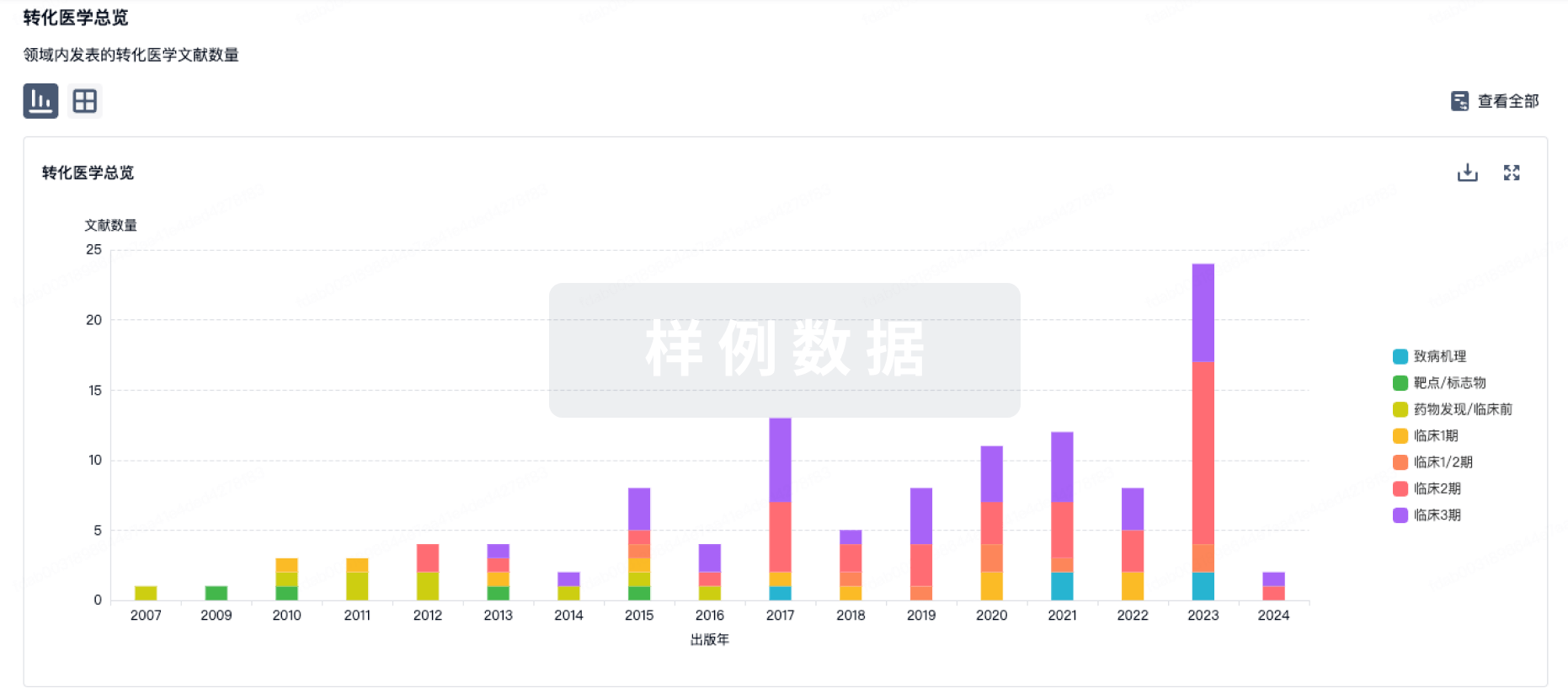
药物交易
使用我们的药物交易数据加速您的研究。
登录
或
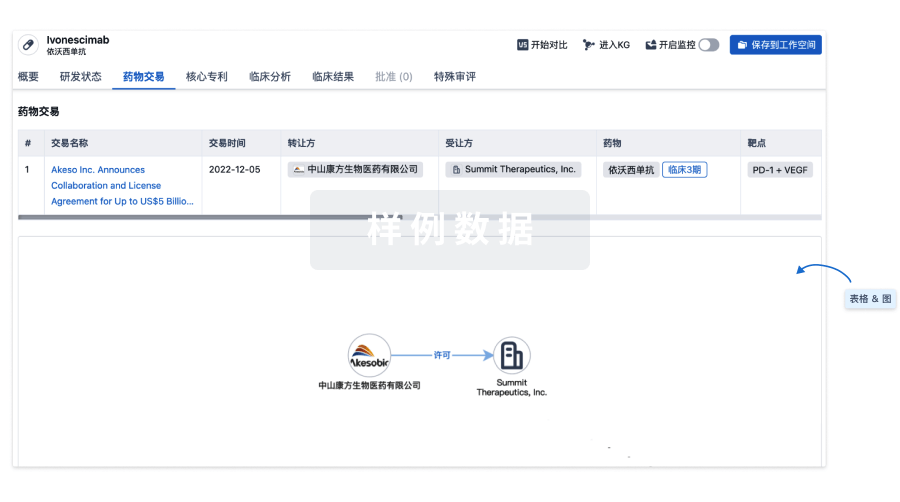
核心专利
使用我们的核心专利数据促进您的研究。
登录
或

临床分析
紧跟全球注册中心的最新临床试验。
登录
或
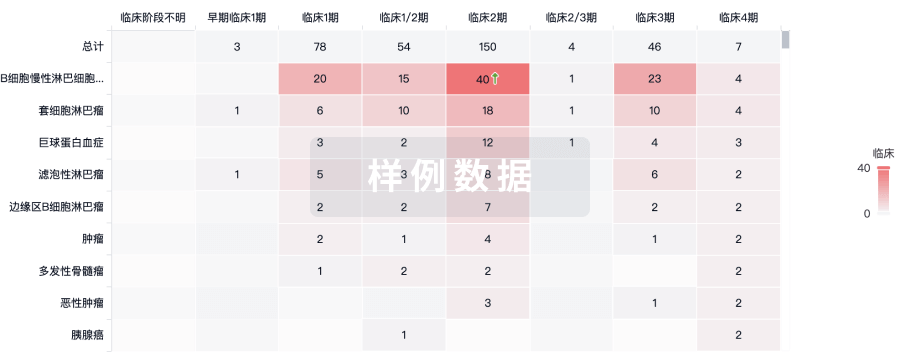
批准
利用最新的监管批准信息加速您的研究。
登录
或
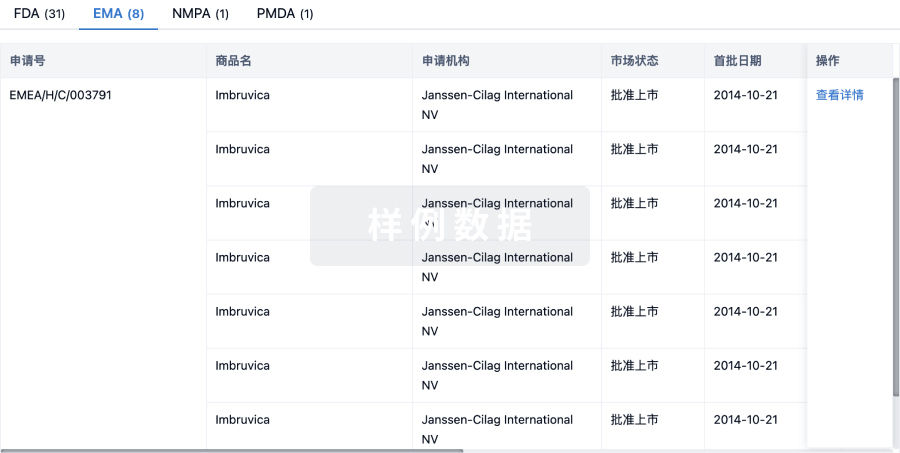
特殊审评
只需点击几下即可了解关键药物信息。
登录
或
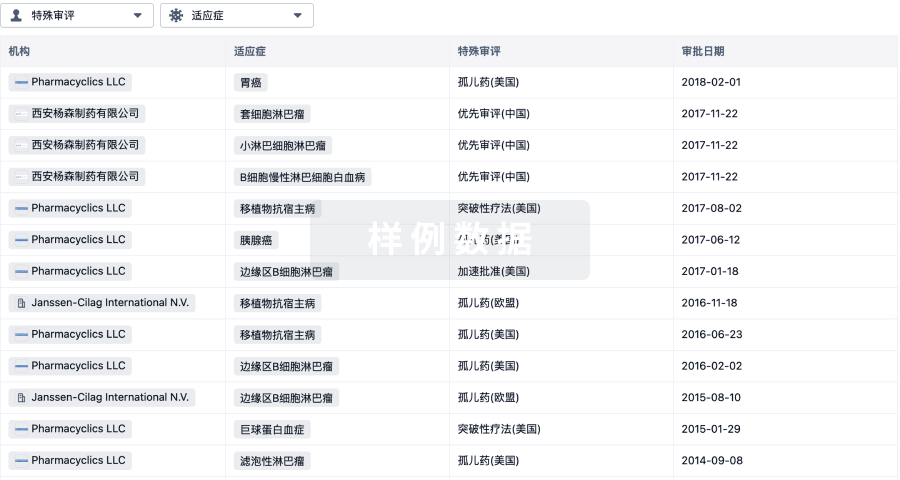
生物医药百科问答
全新生物医药AI Agent 覆盖科研全链路,让突破性发现快人一步
立即开始免费试用!
智慧芽新药情报库是智慧芽专为生命科学人士构建的基于AI的创新药情报平台,助您全方位提升您的研发与决策效率。
立即开始数据试用!
智慧芽新药库数据也通过智慧芽数据服务平台,以API或者数据包形式对外开放,助您更加充分利用智慧芽新药情报信息。
生物序列数据库
生物药研发创新
免费使用
化学结构数据库
小分子化药研发创新
免费使用


